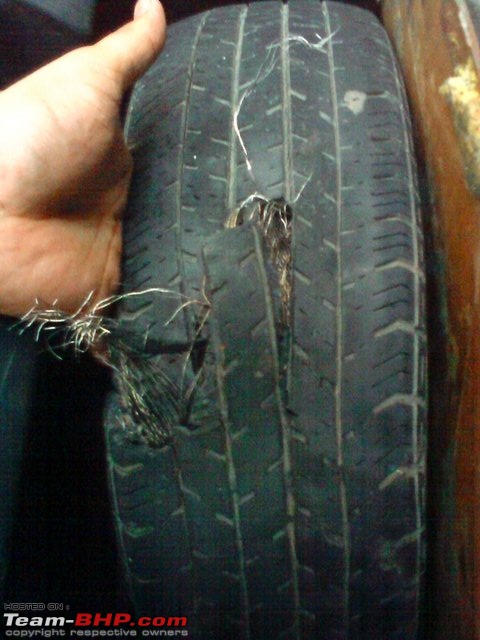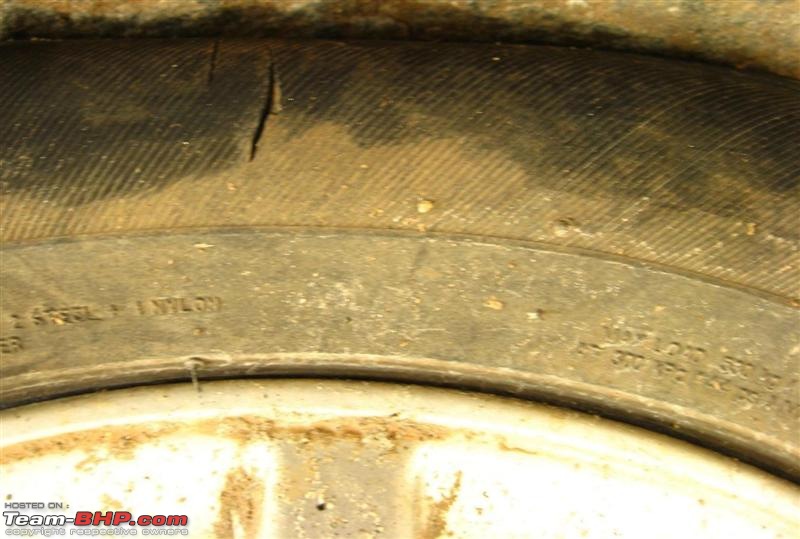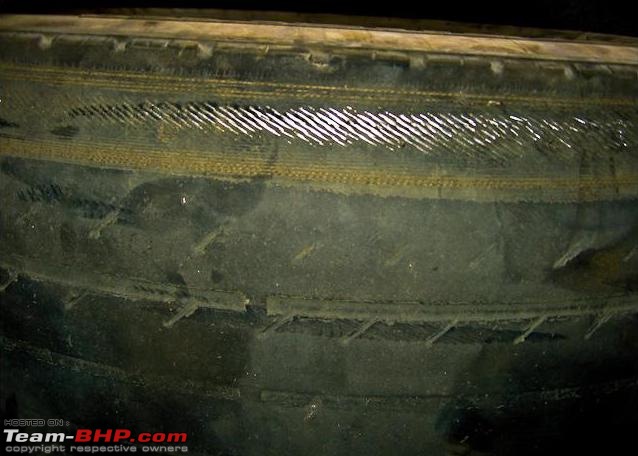Team-BHP
(
https://www.team-bhp.com/forum/)
-
Road Safety
(
https://www.team-bhp.com/forum/road-safety/)
There isn’t a doubt that a tyre blowout ranks the highest on any highway driver’s list of fears. With good reason, as a tyre burst could lead to a complete loss of car control. With SUVs & MUVs, there is the possibility of a flip-over too. A blowout is dangerous no matter how good a driver you are or how safe your car is.
The good news is, with tyre technology continually improving, blowouts are becoming an infrequent occurrence. Still, they do happen and it's best that you know what to do if you suffer one.
How to handle a Tyre Burst:
• Start with maintaining a safe driving speed; there are just no two sides to this. The lower your speed, the higher your chance of survival. A blowout at 80 - 90 kph will be far less dramatic than one at 140 - 150 kph. Indeed, if you survive a tyre burst at 150 kph, consider it a gift of God.
•
Do NOT slam on the brake pedal. Of course, this is easier said than done, as our brains are hardwired to instinctively jam the brake pedal in an emergency. Hard braking is actually the worst thing you can do as it will further imbalance the vehicle and throw it out of control.
• Don’t abruptly take your foot off the accelerator. Do it slowly & gradually. In fact, Michelin recommends that you maintain accelerator input momentarily, before releasing it slowly. The deceleration force from a blown tyre is so strong that your car will anyway slow down rapidly. If you have engaged
cruise control, be sure to disengage it immediately.
• Try your best to keep the vehicle pointed straight. Cornering or turning with a blown tyre will greatly upset the car’s composure. If your car is pulling to one side, you might need to pull the steering in the opposite direction to keep it going straight. This is critical, else you risk drifting into the road divider or worse still, the opposite lane.
• Do NOT attempt to over-correct. The key is to maintain the vehicle’s stability. A sharp yank of the steering wheel can result in a rollover. Even when you have gained control and are slowly moving to a safe parking spot, do so with the mildest steering inputs possible.
• Allow the vehicle to gradually coast to a stop. Use engine braking if necessary. Lightly engage the brakes only when your car has decelerated to a slow speed. Use the turn indicators and pull over safely off the road. Drive on the bare metal wheel if you have to, but do NOT stop in the middle of the road as you run the risk of getting rear-ended by a speeding car. Remember to activate your hazard lights when stopped.
Other Important Points:
• If your car pulls to the left or right side and the steering has gotten heavier, either of the front tyres has burst. The direction that the car pulls in is the side of the damaged tyre. On the other hand, if your car weaves, a rear tyre has blown. Again, don’t brake. It can lead to your car fishtailing.
• Always drive with
both hands on the steering wheel. It’s difficult to control the car in an emergency situation if you have only one hand on the wheel (and the other holding a coffee cup).
• Understand that your car will behave very differently with a blown tyre. Effectively, the vehicle now has only 3 contact patches with the road (instead of 4). Any sharp inputs (steering, brake, accelerator) must be avoided.
• If you drive an SUV or MUV, the probability of a rollover is extremely high. SUVs also have a greater chance of losing stability and steering control. Maintaining a conservative cruising speed is recommended.
• Rubber parts or a broken wheel could have damaged other components of your car. Have a mechanic thoroughly check your car before fitting the spare wheel and driving away. If the extent of damage is severe, call for a tow truck. Most car manufacturers & expressways offer road side assistance now.
• The situation worsens if the roads are wet. It’s best to maintain a lower driving speed in the monsoons. On the flip side, the odds of an overheating tyre are also lesser in rain or cold weather.
Click here to view our article on safe driving in the monsoon season.
• Above all, try to remain as calm as possible. You shouldn't panic and you certainly shouldn't overreact. In most cases, but not always, a tyre burst is accompanied by a
blast sound or a loud pop.
Reducing the odds of a Tyre blowout:
•
Under-inflation is the NO.1 cause of tyre bursts. Some studies suggest that it is responsible for 75% of all blowouts. Under-inflated tyres suffer from excessive flexing and thus, overheating. Be disciplined in checking the air pressure of all tyres (
including the spare) before hitting the highway. Always check the pressure when the tyres are cold (typically, less than 5 km of recent running). Invest in a high quality pressure gauge as petrol pump readings may be inaccurate.
• Check the air pressure every week or fortnight. This way, a small puncture (also known to cause blowouts) will catch your attention.
• There is nothing more critical to safe driving than healthy tyres. Visually inspect all tyres (
including the spare). If you spot any bulges or cuts, that is bad news. Tyres can also get damaged by impact against kerbs, dividers and large potholes.
• Use tubeless tyres. The old tube-type tyres have a higher chance of a dangerous blowout. Good news is, tubeless tyres are OEM fitment on nearly all passenger cars sold today, and the norm in the after-market too.
• Use high quality tyres from a reputable brand. Avoid cheap, unknown imports (
example). In addition, never buy used tyres or retread your old tyres. It must be added that runflat tyres can be lifesavers in a blowout situation.
• Check the remaining
tread depth of your tyres. Not only does additional tread depth help prevent punctures, it also greatly helps grip levels. If the tread has worn out, get a new set immediately.
• If your tyres are over 5 years / 40,000 kms old (lesser for performance rubber like the Eagle F1), you should consider replacing them. The older & more wornout that your tyre is, the higher the chance of a blowout.
• Never overload the vehicle. Ensure that your tyre’s load rating (specified on the sidewall) and vehicle payload capacity are never exceeded.
• Avoid approaching the '
speed rating' of your tyre. If you do a lot of highway travelling, ensure that your tyres have a rating well above your average highway speeds.
• Don’t get temporary / shoddy puncture repair work done. The mushroom + plug type repair is the most recommended.
Click here to view a pictorial explanation of the plug-type puncture repair process.
• If a tyre has suffered sidewall damage, get rid of it.
Link to Related Thread. Keep in mind that driving a considerable distance on a puncture can damage the sidewall.
• Stability Control Programs (e.g. ESP) are lifesavers in a tyre burst situation. Consider this when shopping for your next car.
• While tyre sealants cannot prevent tyre overheating (and eventual blowout), they can fix slow punctures and thus prevent under-inflation.
• If your car is equipped with poorly designed wheel caps, get rid of them. Some wheel caps can actually rub against the sidewall & damage it.
Link to Related Post.
• Concrete roads
might make the tyre run hotter.
Here’s a link to SS-Traveller’s post on the same.
• It is recommended to take a break after every 90 - 120 minutes of driving. This refreshment stop will not only do the driver some good, but also allow the tyres, brakes, clutch etc. to cool down. Give your car & tyres a visual check during these
chai breaks.
•
Click here to view Samurai's excellent article on Road Trip Preparations.
Pictures: (Credit to multiple Team-BHP Threads)
A burst tyre:

Sidewall Crack Example 1:

Sidewall Crack Example 2:

Tyre Bulge Example 1:

Tyre Bulge Example 2:

Severely wornout tyre with visible steel belts :Shockked:

Super article, thanks!
Myth 1: "High tyre pressures are what cause tyre bursts!"
This is NOT the cause. What causes most bursts is not the air pressure in the tyre, but the excessive flexing of sidewalls due to low inflation pressure. This flexing not only generates heat (via additional friction), but also wears and weakens the tyre - eventually leading to a tyre failure (blowout!). It's better to be 4 psi over recommended pressures than 4 psi under it. Especially when traveling at high speeds or with heavy loads.
Myth 2: "It's very hot today, so i should fill less air pressure na! (since hot air expands, DUH!)"
Unfortunately this reasoning is quite popular in India. The truth is that by under-inflating your tyres in hot conditions you are only adding to the sidewall flexing, heat generation and stress that the tyre will have to endure on that already hot day - effectively making it more likely to fail.
cya
R
Gentlemen Thanks a ton for the info you have shared. I have always been curious on what causes a bulge in the side wall of tyres [Could under-inflation be the primary cause], I have experienced this in one of previous vehicles and did not receive an explanation that i could relate to. thoughts would be much appreciated.
Best - ML
Quote:
Originally Posted by Motoringlover
(Post 2956070)
I have always been curious on what causes a bulge in the side wall of tyres
|
Most common reason is severe impact (say you hit a pothole really hard), or a manufacturing defect. Some import tyres with super soft sidewalls bulge easily. Someone I know had 3 tyres of his Jag go bad with bulges. The car had covered 10,000 kms only.
Can we use the handbrakes on and off to slow down the car in case of a front tyre burst , or that will also hamper the stability of the car .
Most of the car in india doesn't have disc brakes on the rear wheel , so the chances of wheel locking will be very less ( i think so ) , so will applying handbrakes help ?.
Quote:
Can we use the handbrakes on and off to slow down the car in case of a front tyre burst , or that will also hamper the stability of the car .
|
Stick to the first post and the chances of slowing down is more. Engine brakes are the best. If manual downshift to reduce speed. This does help.
I didnt have a blow out but a puncture and i was driving at close to 120. I continued driving straight line, slow down naturally and using gear shift down and engine brakes and then parked the car safely.
The tyre was a goner after this extra 300-500 m or driving but i am absolutely sure if i tried braking or doing something stupid i may have ended up rolling or dont know what it is.
I have replaced that tyre now and post 30K km will replace the rest.
Quote:
Originally Posted by Schoudhury
(Post 2956102)
Can we use the handbrakes on and off to slow down the car in case of a front tyre burst , or that will also hamper the stability of the car .
Most of the car in india doesn't have disc brakes on the rear wheel , so the chances of wheel locking will be very less ( i think so ) , so will applying handbrakes help ?.
|
Handbraking actually very prone to wheel locking irrespective of disc brake or drum brake. Other experts can comment.
The best method to avoid the burst as mentioned in above post
1. Regularly inspect tyre pressure and fill 1-2 psi more than recommended.
2. Inspect your tyre for sidewall cut, bulge etc once in a month.
Also,
When you go for tyre rotation or balancing, do inspect all tyres yourself, than relying on alignment/balancing center. This is best place, where you can inspect all tyres from inside, which is difficult when fitted.
Fantastic thread and a very needed one, many are not aware about the dangerous caused due to the tyre blow burst. this thread will certainly aid in educating many.
Also, Overloading is another issue. i have come across many who try to fit more then 5adults in their sedans/hatch's and lot more in UV's.
Quote:
Originally Posted by Motoringlover
(Post 2956070)
I have always been curious on what causes a bulge in the side wall of tyres thoughts would be much appreciated.
|
A broken steel/fiber ply belt in the sidewall of the tire can cause the tyre to bulge at these points. Normaly this is caused by two things..
1. A manufacturing defect which is hard to detect while buying the tyre.
2. Heavy impact to the tire side wall (like hitting a pot hole or scraping the tyre on the footpath curbs).
You need to get the tire replaced as soon as possible as it is a huge safety hazard because the integrity of the tire has been lost (hence the bulge as it starts to loose shape). This might cause the tire to blow making you to loose control causig damage to yourselves and other fellow drivers on the road... :eek:
Be SAFE & Ride SAFE !! :thumbs up
An apt thread, specially when we all saw the price that Sam had to ultimately pay!!
Coming from an aviation background, where we are taught to deal with this emergency at much higher speeds, I would like to bring out two points:
1. The point about maintaining and if possible increasing speed in case of a blowout (or burst as we call it) is a life saver. As the speed reduces, the drag from the blown out tyre increases thereby increasing the pull to the blown out side. Hence, maintaining speed (which will require additional accelerator input) will help you buy time and prepare for subsequent actions.
2. The physical force required to maintain the steering wheel in position to keep the vehicle going straight can take many off guard. It is a LOT more than the forces on the wheel that one is used to. Be ready for it!
5 years or 40000 km is rightly the limit. I have had experience in my Swift with the JKs. Though the tyres clocked only 31K kms it was more than 5 years old and one of the tyres lost shape which, luckily was immediately noticed in the steering feel while driving back from Mangalore last February.. I changed to the stepney at the nearest outlet where the guy immediately diagnosed the problem.
Fine informative thread. The individual experiences and corrective action by members will definitely add further value.
| All times are GMT +5.5. The time now is 15:24. | |







